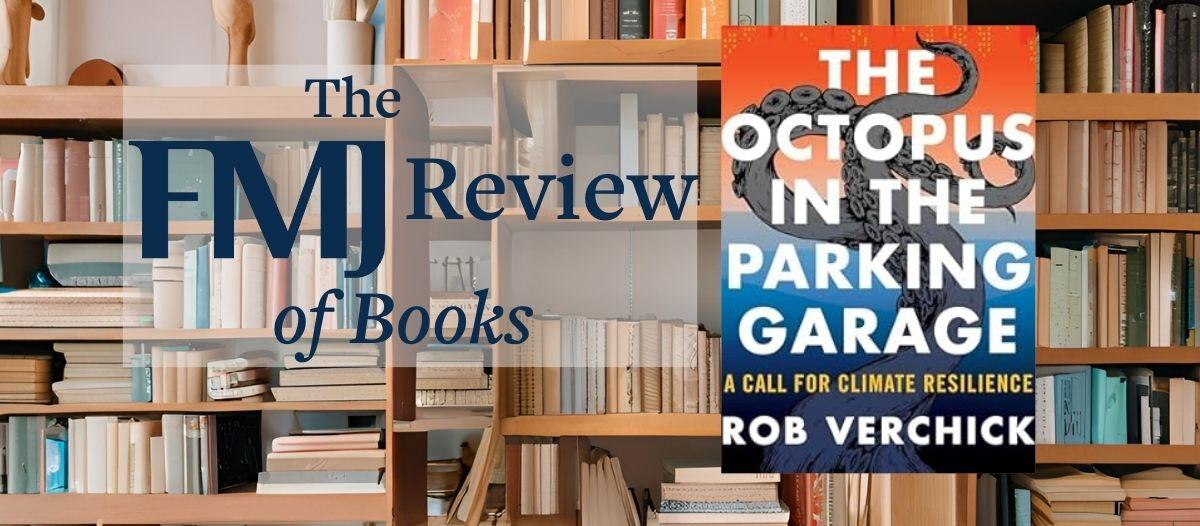Book Review
The Octopus in the Parking Garage: A Call for Climate Resilience

The introduction: A Scream Heard Round the World
The frightening image of Eduard Munch’s "The Scream" has been used in many ways, but Rob Verchick’s references to the painting in his book, as a reaction to an octopus spotted in a high-end Miami condominium parking garage, is certainly one of the most unique. The first mention of this image is in a description of Labor Day 2020 when he was kayaking in Washington’s Puget Sound and experienced existential panic as he was engulfed in an orange sky colored by sentiment from the enormous wildfires that devastated the northwestern forests.
The second reference describes what Munch had experienced on a winter day in 1892 when he stopped during his walk and was overwhelmed by a “wave of sadness” when the atmosphere reddened and “flaming clouds like blood and swords” filled the sky. He described the feeling as “a vast, endless scream had passed through nature” due to unusual climatic conditions at the time. When Verchick finally saw the painting in Oslo he was surprised by the small size and what he thought was haphazard execution. His experience was indicative of one of the central themes of the book, “Within the wallop of pain and terror that so many of us feel in this carbon-drenched epoch, there can be relief when one chooses to stop, inspect and reorganize one’s perception…it need not paralyze us.
This book is Verchick’s personal cry for pausing a while and accepting climate is changing our world faster and more ferociously than anyone anticipated, and we must prepare for this destruction at the same time we work to fix the problems. This very enjoyable, well-researched book (except for one chapter on public lands) should be required reading for all of us in the battle for sustainable development on the planet.
The author: Lawyer & climate activist
Vernick’s degree in English from Stanford University before graduating from Harvard Law School, prepared him not only for an academic career, but also for becoming a great storyteller. After teaching law at the University of Missouri-Kansas City, he moved to New Orleans, Louisiana USA to teach, just in time to experience Hurricane Katrina in 2005. This changed the direction of his work when he realized that dealing with such disasters required not only a geophysical approach, but a social one also. Today he is a leading climate law scholar, having worked under Barack Obama’s presidential administration, where he designed and implemented climate-resilience policies for the government. He teaches law at Loyola, is a researcher at Tulane University and serves as president of the Center for Progressive Reform. He also hosts an informative podcast, “Connecting the Dots.”
Part I: The star is a cephalopod mollusk
The eye-catching cover and title of the book is based on a true story about the discovery of a glistening green pool of water which highlighted the tentacles of an octopus, still alive nearby. It was found by a resident, Richard Conlin, who photographed this strange intruder and posted it on Facebook where it went viral. The condominium is close to the ocean, as is the garage with its drainage pipes that feed runoff into the ocean.
Due to climate change, sea levels are rising and now many of these pipes are submerged and vulnerable to flooding during high tide and an unusually strong gravitational pull of the moon which caused the storm drain to reverse and cough up the unsuspecting octopus.
The first part of the book is an introduction to the history and complexity of resilience.
Rob saw this octopus as a symbol of “an urgent call for recognizing and preparing for the many climate disruptions to come.” The type of preparations necessary are what are necessary for climate resilience.
Part II: The Resilience - SDG Stories
The stories that Verchick has skillfully crafted in Part II speak to his personal experiences and interviews with participants involved in resilience projects in the U.S. These six vignettes represent what could be done to impact the UN's Sustainable Development Goals (SDG) 7, 11, 13, 14 and 15.
-
SDG 7 (Affordable and Clean Energy) and SDG 11 (Sustainable Cities and Communities): Urban Power Grids
The U.S. power grid is called “the world's biggest machine” with 700 power plants, 15,000 substations and 6 million miles of wire. Some of their locations are problematic, subject to rising sea levels. Others have been damaged by major hurricanes like Sandy, Harvey, Katrina, Irma. In 2017, Hurricane Maria devastated Puerto Rico and knocked out 80 percent of the island’s electric grid, which took 11 months to restore. Added to these problems is most of this infrastructure is powered by oil and natural gas.
To build resilience to the power grid for durability and flexibility, it is required to harden the grid by fixing the physical infrastructure problems, smarten the grid with the latest innovative technologies and green the grid by transitioning to renewable energy sources like wind and solar. An example of hardening is the work one New York City’s electrical provider is doing for resilience. Following the destruction of Hurricane Sandy in 2012, they were required by the state’s utility commission to work with other alliance partners to develop a long-term, scientific climate resilience plan. By 2018 most of the hardening work was complete and, in the following year, the plan was expanded for the years 2020-80. Unfortunately, to date, no other utility companies in the state have followed suit.
-
SDG 13 (Climate Action): Coastal Degradation
There are two causes for the problem of destruction of our coastlines: climate change and human intervention. Warming waters are causing seas to rise by 10-12 inches which is endangering coastlines. In the U.S. alone, these rising waters are threatening the nation’s wealth with half of this land predicted to be under water by 2100.
Then there is the fossil fuel industry which has aggravated this problem since 1901 when oil companies built the industry’s first oil drill off the coast of Louisiana. Now there are 4,500 oil rigs and 10,00o miles of piping off the U.S. coasts making it the largest offshore infrastructure for fossil fuel excavation in the world. Besides contributing to greenhouse gas emissions and undermining the ability to cope with harsher storms, it has also destroyed the country’s valuable wetlands.
State governments must implement long-term coastal resilience plans which identify projects to resist, adjust, or the last resort, retreat strategies, based on the latest science and engineering innovations.
-
SDG 14 (Life Below Water): Coral Reefs
Warmer ocean temperatures are adversely affecting the growth of coral reefs. Nine hundred species of these aquatic environments exist in more than 100 countries which provides fish (one quarter of marine species) for hundreds of millions of people, protecting the coasts from storms with their limestone boulders and thickets and gaining revenue from tourists visiting these locations to experience their mystery and beauty.
Yet they are being threatened by carbon dioxide emissions, overfishing, agricultural runoffs and sewage leakage. Building climate resilience requires reforming water management policies, checking the overuse of resources (like fishing) and restoring habitats as performed by national and local authorities.
-
SDG 15 (Life on Land): Public Lands
Federally owned lands are unraveling as the climate breaks down. Understanding this problem is extremely complex and made this chapter difficult to understand. One of the key issues in the U.S. is how these lands are administered by two different public agencies.
-
-
The Department of Agriculture’s Forest Service manages 154 national forests and 20 national grasslands (25 percent of the portfolio). This service is facing a tension with what it manages as it leases to the logging industry (a $15 billion industry) and what lands are identified as refuges to be preserved.
-
The Department of the Interior’s Bureau of Land Management manages the majority of the portfolio, which includes land for coal, grazing, mining leases, recreation (streams, rivers, lakes, trails), conservation, and wilderness areas, besides renewable energy projects.
-
Verchick suggests changing existing laws that govern these lands to embrace climate resilience and increase the resources within these agencies to put higher priority on creating the right framework to build resilience.
-
SDG 15: (Life on Land): Wildfires
The U.S. is one of the world’s most forested countries. Wildfires are growing more frequent having doubled from 1984-2015, particularly in the west and southwest where they are expected to increase 30 percent. From 2002-11 the damages amounted to US$7.9 billion (three times higher than the previous decade). The devastation results in the loss of lives, property, animal and plant species, and the release of carbon dioxide from the trees, ozone and particulate matter. The fine particles from the later can be extremely dangerous when they are breathed into the lungs and go into the bloodstream, they are considered one of the largest environmental risks in the U.S.
-
SDG 11 (Sustainable Cities and Communities): American Migration
In some ways, this is the most difficult story, because despite resilience efforts, it means that resisting and adjusting efforts were not enough and is the only answer. Millions of people are in danger of being displaced from their locations by climate change before the end of the century, particularly those living on the coasts due to sea rise and land erosion. In Florida, the octopus is not the only flood victim. One quarter of Florida residents risk some form of flooding affecting 3.5 million in the coastal areas and 1.5 million inland. Most of these people are the poor, called the “climate underclass” which makes it a moral duty that the government face this problem which it has mostly ignored to date.
Verchick recommendations are that Congress should pass legislation to create a new federal agency to oversee and advise voluntary, community-led climate relations headed by a strong leader. This agency could create an inventory of funding opportunities and legal authorities, as well as assign projects to existing agencies, like the Environmental Protection Agency and National Oceanic Atmospheric Administration.
Conclusion: Power our planet to be beyond resilience
While Verchick U.S. resilience stories are mostly optimistic, it is the Rockefeller Foundation’s (RF) plan for power distribution that gives me the most hope for climate resilience globally. The RF was behind two recent international gatherings in Paris. One was their sponsorship of a three-hour rock concert performed at the foot of the Eiffel Tower. The voices of stars like Lenny Kravitz and Jon Batiste were heard by people around the world to inspire them to save tomorrow. Following the event, world leaders, multilateral development banks and private investors met at a summit to achieve that by creating a new global financing pact.
Their goal of this gathering was to achieve a new energy contract between the north and south and to make it easier for vulnerable countries to not only finance their resiliency but help to be in much better shape than before the energy investment. The concept for this summit was strikingly like the plan RF President Dr. Rajiv Shah and designer of the Global Energy Alliance who spoke at the event, had outlined in an interview with the Financial Times. The results of this new pact are what the writer and risk analyst Nasim Nicholas Taleb describes as making these undeveloped countries antifragile, a state beyond resilience. In this uncertain environment, a country can not only survive climate change, but grow better because of it.

Nancy Sanquist, IFMA Fellow, is a professional involved in the built environment for the last few decades. She is the Past Chair of the IFMA Foundation, with which she has worked for the last six years. She is a co-founder of the Global Workforce Initiative (GWI) and the Workplace Evolutionaries, and is the author of many articles and co-editor of books on FM/CRE, technology, architecture, urban planning and maintenance including the award-winning book series titled “Work on the Move (1&2).” She is working on a new book on “Reimagining Place in the 21st Century.”
Read more on Occupancy & Human Factors and Real Estate
Explore All FMJ Topics









